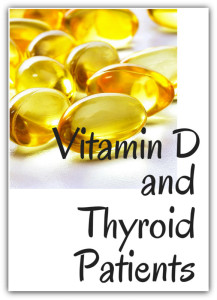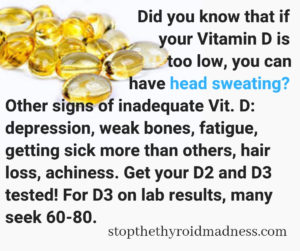The following article was written by thyroid patient Marge about Vitamin D. Marge served as an admin in the Yahoo Natural Thyroid Hormones group for many years. Janie Bowthorpe, site creator, has also added a few tidbits here or there.
*************
One of the many downsides of being hypothyroid is the inability to absorb and/or metabolize a variety of vitamins and minerals, mostly due to low stomach acid.
And unfortunately, many Vit D challenged patients think that all they have to do is sit in the sun and they will create enough Vitamin D. Not so for many hypothyroid patients! I was fortunate to have a decent doctor who tested my Vitamin D level when knowledge about vitamin D deficiency was in its infancy. My level was 19 with a normal range of 30 to 100 ng/ml. He put me on high doses of Vitamin D3. Imagine my surprise when six months later, I didn’t need my daily asthma inhaler and I didn’t have a cold all year!
Today, there are mountains of research into a myriad of issues that can be affected by Vitamin D. There is also a forward-thinking Vitamin D Council that will keep you apprised of current findings. In the Council’s December 21, 2013, newsletter, it reported about a study done in South Korea which found a link between vitamin D deficiency and autoimmune thyroid disease (AITD).
The Vitamin D and Hashimoto’s Antibodies connection
Researchers have found that “people who were deficient in vitamin D were much more likely to have TPO-Ab positive tests, [which is related to having Hashimoto’s].” TPO-Ab is a marker for autoimmune thyroid disease and measures the level of antibodies specific to fighting thyroid-related cells. The Council newsletter went on to say, “The researchers calculated that those who were severely deficient in vitamin D had nearly twice as high the risk of a positive TPO-Ab test compared to those who were sufficient.”
So, does that mean vitamin D deficiency leads to autoimmune disease or that those with autoimmune disease are more likely to be deficient in Vitamin D?? Unfortunately, the researchers haven’t figured that one out yet and/or only offer opinion. But some research shows a strong connection!
The one thing researchers do know is “…thyroid treatment isn’t optimal, and may not work, if you do not have adequate vitamin D for the crucial final metabolic step, which takes place at the site where thyroid hormone actually works. This happens inside the nucleus of the cell. Vitamin D needs to be present at sufficient levels in the cell in order for the thyroid hormone to actually affect that cell. That is why vitamin D is so crucial.”
Can I have low vitamin D and NOT have an autoimmune connection?
Yup. We see that a lot. And contrary to the opinion that we only get Vitamin D from sun exposure, we know that vitamin D is also coming from what we eat. Thus, low stomach acid due to being hypothyroid of any cause can result in lowered levels of Vitamin D.
The ten most important points you need to know about Vitamin D, with AITD or not:
- Vitamin D is not really a vitamin. Vitamin D is a fat-soluble steroid hormone precursor that you get primarily from either sun exposure or supplementation. A very small amount comes from a few foods we eat.
- Vitamin D helps maintain normal levels of calcium and phosphorus in the bloodstream. Current research has discovered that vitamin D levels can also impact a wide range of health issues, such as:
* Cancer (Breast, Ovarian, Colon, Non-Hodgkins Lymphoma, Kidney, Endometrial, Prostate)
* Type 1 Diabetes
* Fractures/Osteoporosis
* Pregnancy Complications
* Multiple Sclerosis
* Cardiovascular disease
* High Blood Pressure
* Asthma - The vitamin D that you take into your body is changed by your liver into a substance called 25(OH)D. Vitamin D (25 (OH)D) is usually measured on a scale of 30 – 100 ng/ml. Below 30 is commonly considered deficient.
- To determine whether you need to supplement vitamin D, you should test the 25-hydroxy D lab test, which measures 25(OH)D. The Vitamin D Council recommends testing every 3-6 months when you’re trying different regimens to figure out how much vitamin D you need to maintain your optimal level. Once you’ve reached your optimal level, GrassrootsHealth recommends, “From that point forward, testing should be done at a minimum of once a year, ideally in the early spring (late March, early April) when your vitamin D level is the lowest. It’s a good time to adjust to make sure you don’t get too low.”
- The Vitamin D Council suggests that “a level of 50 ng/ml is the ideal level to aim for, with a range of 40 to 80 ng/ml.“ And there used to be mention that ideal is 60 — 80, which honestly, many are still shooting towards today. Since people with AITD aren’t healthy and have factors that impair their production, absorption and utilization of vitamin D, the minimum 25(OH)D level for those with AITD may be need to be higher than for healthier people.
- The recommended daily amount of vitamin D3 is also a matter for debate. For example, this amount ranges from 400 IU/day by the US government, 1,500 — 2,000 IU /day by the Endocrine Society, to 5,000 IU/day by the Vitamin D Council. Grassroots Health has a chart on its web site that tells you how much vitamin D to take to change your level and says that intake of 35 IU/lb of body weight estimates the ideal daily dose. These amounts can be affected by amount of body fat, gut inflammation, high cortisol levels, auto-immune issues, impaired fat absorption, use of drugs that reduce absorption, aging, and genetic defects, Since intake amount doesn’t guarantee optimal levels, testing on a regular basis is highly recommended. But many thyroid patients have discovered that they don’t begin to raise their levels until they are at 5000 IU at the least, and many state they need 10,000 IU’s daily, probably due to absorption issues inherent with our low stomach acid levels. See #9 below.
- The Vitamin D Council recommends taking vitamin D3 rather than vitamin D2. Vitamin D3 is the type of vitamin D naturally produced by your body in response to sun exposure, while vitamin D2 is not. In the United States, most over-the-counter vitamin D supplements are D3. Other than that, it doesn’t matter what form of vitamin D you take, whether it’s in a capsule, tablet or liquid. For most people, vitamin D is easily absorbed in the body and you don’t need to worry about what time of day you take it or whether you take it with meals.
- Vitamin D is fat-soluble, which means your body has a hard time getting rid of it if you take too much. The Vitamin D Council recommends taking no more than the upper limit of 10,000 IU/day for adults, though some researchers consider this conservative. Signs of toxicity are low appetite, nausea, vomiting, thirst, excessive urination, weakness and nervousness.
- The way that vitamins and minerals work in your body is interconnected. How well vitamin D works depends on the amount of other vitamins and minerals that are present in your body. The other vitamins and minerals needed to help vitamin D work well are called cofactors and, without these cofactors, supplementation can have undesirable effects. Vitamin D has a number of cofactors. According to the Vitamin D Council and others, the ones listed below are the most critical and should not be overlooked: Magnesium, Vitamin K2 , Zinc, Boron, and Vitamin A
- Most important for those of us who are hypothyroid, the symptoms of low vitamin D can look like low thyroid, such as fatigue and general aches and pains. Since vitamin D is critical for bone health, adequate levels may be necessary to prevent bone problems often associated with poor thyroid hormone replacement with T4-only. Plus, vitamin D levels (along with levels of iron and cortisol) need to be optimal for thyroid receptors to respond properly and for thyroid medications work properly.
What test do I do?
The 25-hydroxy (25OHD) vitamin D blood test, by itself, is perfectly fine and can be preferred. The 25-hydroxy represents your body’s primary circulating form of vitamin D and the precursor to the below.
Some choose to also test 1,25-dihydroxy vitamin D blood test to detect kidney disease, which will be low with the disease”. This test can also discern parathyroid dysfunction and you can work with your doctor on detecting this.
Bottom line, how much Vitamin D should I take with all the different recommendations and opinions?
Some thyroid patients have noted that they need at least 10,000 IU’s to raise their levels because of absorption issues which are rampant for thyroid patients. Some, because of what’s called the VDR genetic mutation have to continue using that much. The latter means the receptors don’t do a good job grabbing the D.
Another source states this: 1,000 iu’s of Vitamin D3 will raise your Vitamin D level by 7 — 10 ng/ml. So, for example, if you want to raise your Vitamin D level by 20 ng/ml, you should take 2,000 iu’s.
Also note that depending on what measurement your lab uses, 40 — 60 ng/ml is 100 — 150 nmol/L.
Here are charts: http://grassrootshealth.net/media/images/chart-serum-level-intake-5-by-3-ngmla-both-charts-single.pdf Bottom link, see what works for you avoid taking too much.
What if Vitamin D makes me feel horrible?
TIme to look at your parathyroid. If you have a parathyroid problem, it can make you feel bad with Vitamin D supplementation.
FROM JANIE
I’ve seen the recommended levels for Vitamin D all over the board over the years. I choose to go by the former recommendation by the Vitamin D Council, which is 60-80.
Sources:
www.vitamindcouncil.org
www.mercola.com
www.grassrootshealth.net
http://health.howstuffworks.com/human-body/systems/endocrine/understanding-thyroid-metabolism.htm
http://www.goodhormonehealth.com/articles.html
http://www.wilsonssyndrome.com/vitamin-d-thyroid/)
http://chriskresser.com/the-role-of-vitamin-d-deficiency-in-thyroid-disorders
Important notes: All the information on this website is copyrighted. STTM is an information-only site based on what many patients worldwide have reported in their treatment and wisdom over the years. This is not to be taken as personal medical advice, nor to replace a relationship with your doctor. By reading this information-only website, you take full responsibility for what you choose to do with the information on STTM or its outcomes. See the Disclaimer and Terms of Use.

